Post Singapore, we continued heading east, flying across the South China Sea from Johor Bahru in Peninsular Malaysia to Kota Kinabalu in East Malaysia. Since it’s the north section of the island of Borneo shared with Indonesia (and Brunei), it’s often referred to as Malaysian Borneo (and often what the rest the world is referring to when they talk about “Borneo”). Malaysian Borneo is split into the states Sarawak, Sabah, and the federal territory of Labuan. We focused on the more tourist-friendly Sabah, with bases in Kota Kinabalu and Sandakan.

Renowned for its natural resources, we came to Malaysian Borneo for its wildlife and natural scenery. Mount Kinabalu in Kinabalu Park is the highest peak in Malaysia and normally offers great hiking options. However, a 6.0 magnitude earthquake in Sabah in June closed trekking up to Mount Kinabalu until early September, not within our time frame. Sipadan Island has some of the best diving spots in the world, but it was outside of our budget and possibly outside our diving expertise as well. Having said that, we still found plenty else to do in Malaysian Borneo.
Sepilok Orangutan Rehabilitation Center
We may have missed the orangutans in Indonesia (northern Sumatra and Indonesian Borneo), but we made up for it here in Malaysian Borneo. An endangered species, wild orangutans have been threatened by poaching and loss of habitat. From Sandakan, we caught the local bus to drive us out to the Sepilok Orangutan Rehabilitation Center. For more than 50 years, Sepilok has focused on rehabilitating orphaned young orangutans, teaching them how to survive before releasing them back into the wild.

Visitors are encouraged to come and learn more about orangutans and Sepilok has since become one of Sabah’s biggest tourist attractions. However, the priority is still on the orangutans, so visitors are limited to walkways and what they can bring into the forest. Our first stop was at a cute outdoor nursery, complete with jungle gym! Sepilok staff soon brought out young orangutans, holding hands and walking them to the jungle gym. All the visitors crowded around the windows for our first glimpses of these hairy primates.
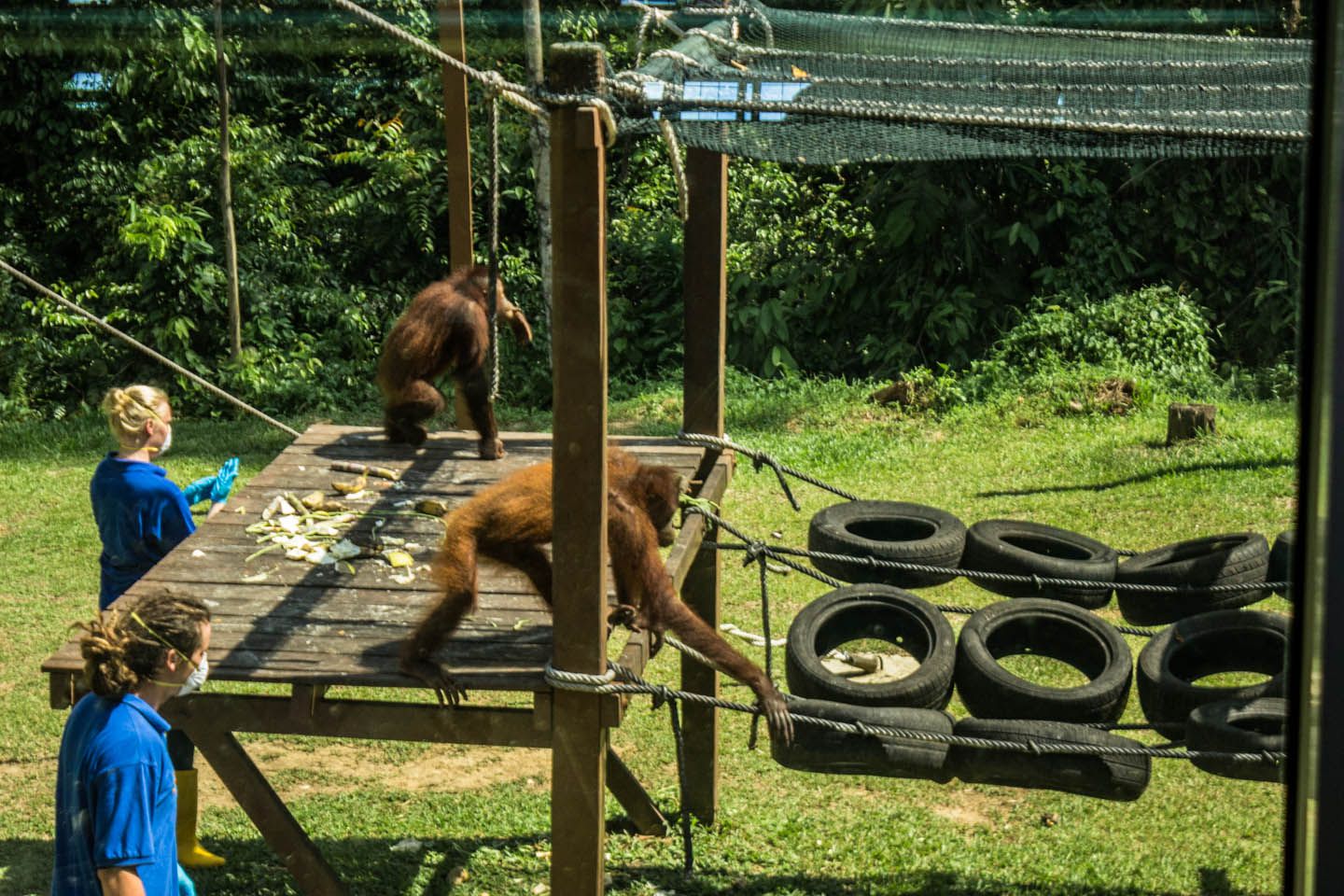
As we watched them swing around on the ropes, one particularly mischievous and smart orangutan attempted an escape. Checking that the park staff had left the area, this orangutan quickly sprinted around the corner of the building and out of sight. A few seconds later, we all watched as a park staff chased after the runaway orangutan around the same corner. Intrigued by the surprisingly turn of events, we all waited with bated breath, staring where both orangutan and park staff disappeared. In another few seconds, the orangutan rolled back into view, as if reluctantly pushed back. A wave of laughter broke out in the viewing room. What a sneaky little orangutan! It’s unexpectedly joyous moments like these that I will remember forever.

We soon left the nursery behind for the main event of the day: the afternoon feeding. Park staff brought a large basket of food to the feeding platforms, with everything from papaya slices and small bananas, to string beans and sugarcane. Orangutan attendance at feedings is generally lower during summer months than in the winter, as there is more food available in the forests for the orangutans to find themselves. Nonetheless, we had our fair share of orangutans come for the feeding that day.

We were thrilled to find that each orangutan had a distinct personality, just like humans. There was the alpha male – bigger, older, and kept to himself. He didn’t eat much, but seemed to be present mostly for his family: a mother and baby orangutan. We felt so fortunate to have the opportunity to observe this special pair. The mother orangutan sat down and ate profusely, shoving food into her mouth, pausing only to take care of her little one when necessary. This was understandable as she no doubt needed all the nutrients she could get. Meanwhile, the baby stayed in the mother’s cocoon, holding onto her and playing occasionally. It was adorable.

Besides the family, a few single orangutans also made an appearance at the feeding platform. The most memorable one was a definite troublemaker. He didn’t eat much, but rather spent most of the time bothering everybody else. The main target was the park staff, who had his pants and shirt constantly pulled by the naughty orangutan, even when the park staff kept slapping his hands away. If anything, it seemed to encourage the orangutan more. He got into fights with other orangutans and poke and prod at others in general. I guess he did make watching feeding time more entertaining for the visitors.
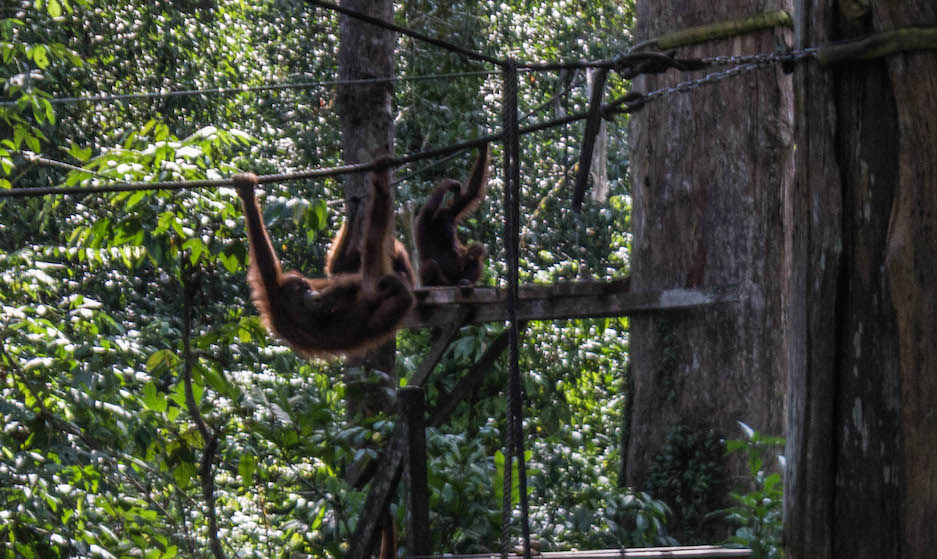
Sepilok made for an enjoyable visit, even though we never got very close to the orangutans. It’s pretty clear by now we need telephoto lenses in the future for capturing wildlife.
Labuk Bay Proboscis Monkey Sanctuary
It turns out that orangutans weren’t the only monkeys in Malaysian Borneo. The title of “biggest nose in Borneo” goes to the proboscis monkey. They are, hands down, the weirdest looking animals I have ever seen. Long nose, beady eyes, orange-reddish fur on the top half, grey fur on the bottom, and a large belly made for a strange combination. Another endangered species, proboscis monkeys are endemic to the island of Borneo.
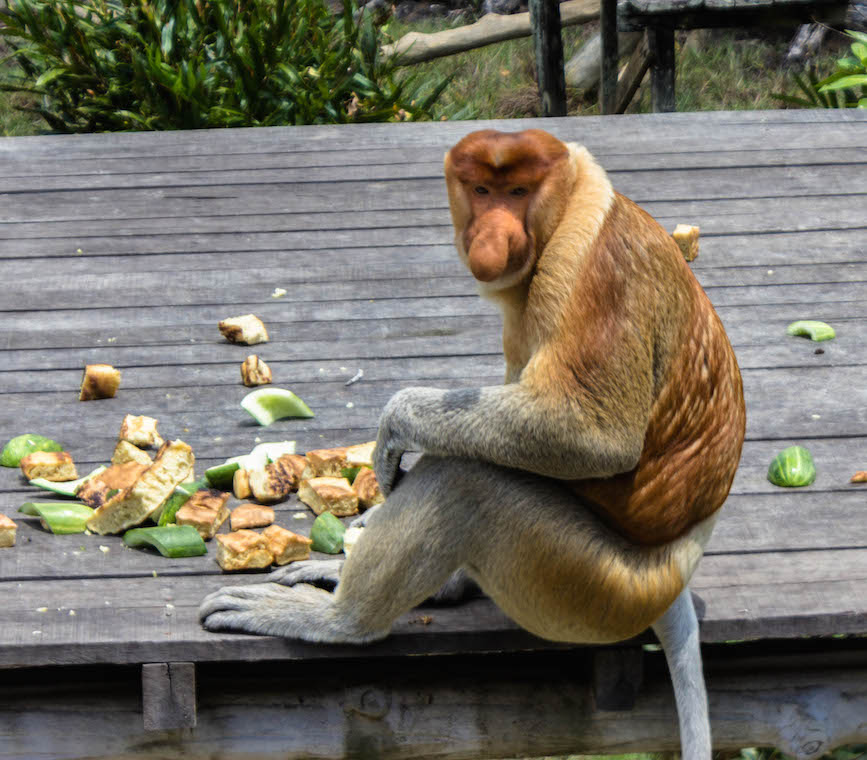
Visiting Labuk Bay was like an unofficial guided tour. A van picked up in front of Hotel Sandakan and drove to the sanctuary as well as within the sanctuary itself. We attended two different feedings and saw different groups of proboscis monkeys. Feeding time at Labuk Bay was much more popular than at Sepilok. Besides watching large groups of proboscis monkeys of various sizes sitting and eating, we also saw them in action. A large male sprinted across the walkway at one point, leaping and scaring a few of the visitors. We even caught two proboscis monkeys fighting on the rooftop, hand-to-hand combat style. Despite seeing more than 50 proboscis monkeys over the course of a day, we never quite got used to their strange appearance.

After lunch and in between feeding times, we watched a BBC documentary that taught us more about proboscis monkeys. Apparently the dominant male usually has a harem of females, ruling his section of forest. The rest of the males join a group of bachelors, one of whom is always trying to kick out the leading male to take all the females for himself. Heavily affected by deforestation and a loss of habitat, we watched the proboscis monkeys’ struggle to survive along with insights into their daily life. It was surprisingly entertaining and educational.
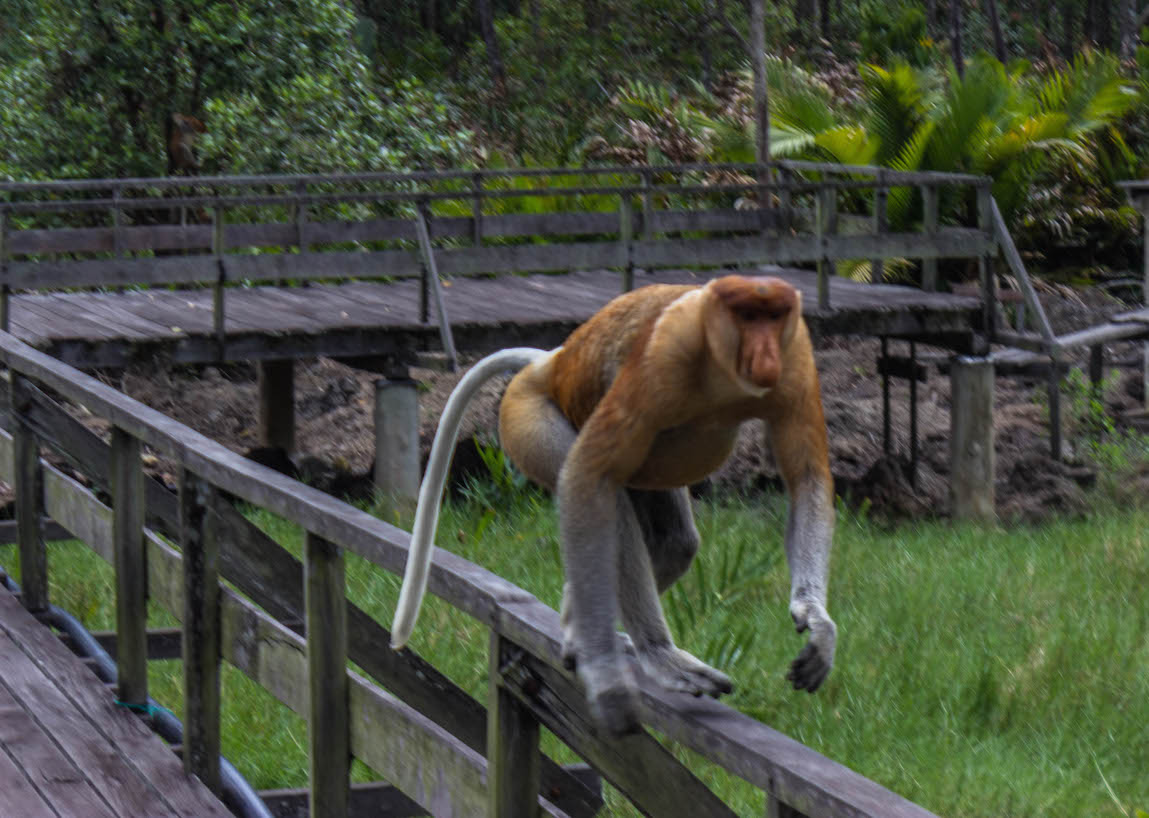
Even though Labuk Bay is a proboscis monkey sanctuary, silvered leaf monkeys also live in the same forests. They look much more like regular monkeys and joined us for one of the feedings. Luckily, each species of monkey was fed completely different things, so there was no competition.
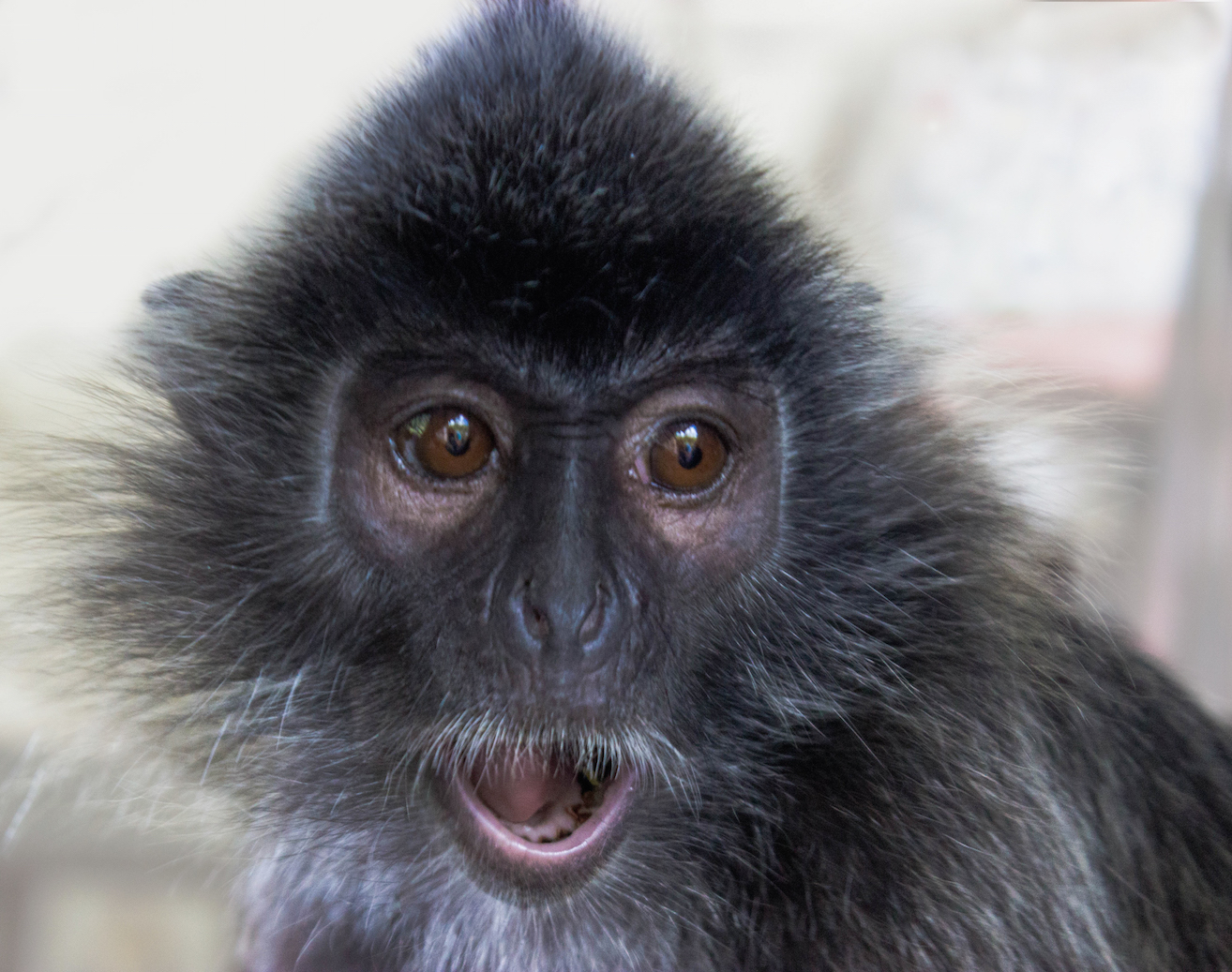
The silvered leaf monkeys were not at all afraid of humans, literally taking string beans from visitors’ hands. We even saw a bright orange baby!

If the monkeys weren’t enough, there were also hornbills living in the forests. With a few bird calls, they flew out of nowhere to a branch near the feeding platform, lined with banana pieces by the park staff. This was easily the closest we’ve ever been to a hornbill and we were able to fully appreciate how beautiful they were. Their wings are especially pretty when fully spread, with long, elegant features. Their large bill seems to have an extra layer on top (almost a second bill), a unique structure known as the casque. We caught a few nice shots of the hornbills.
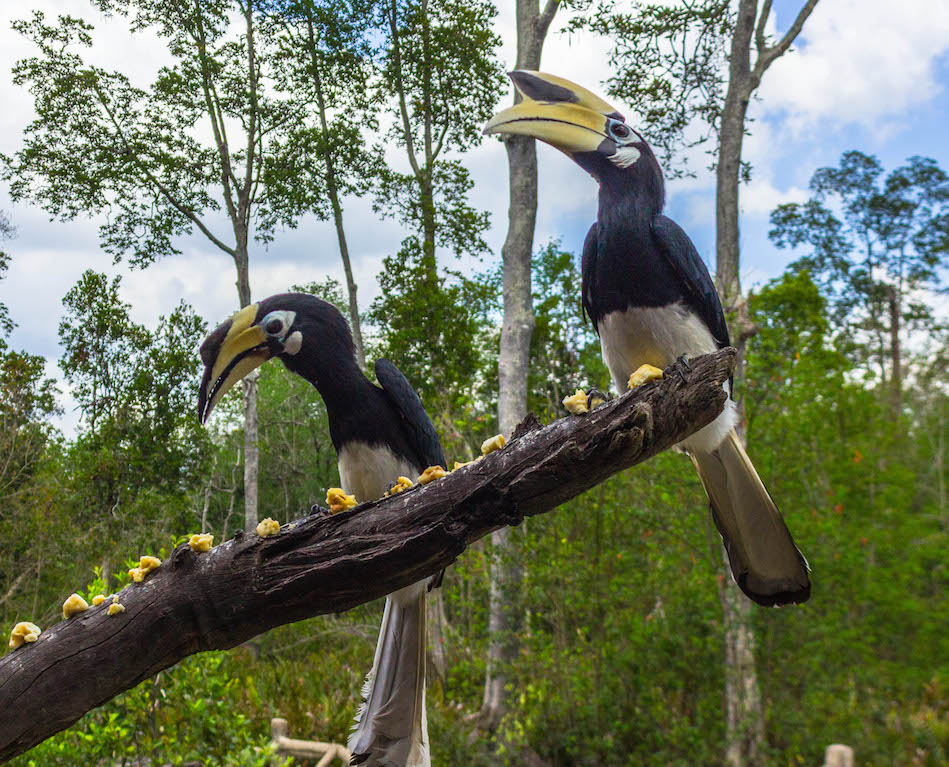
To be honest, we weren’t 100% sure in the beginning whether Labuk Bay was worth the trip, but we were so glad we did! While the whole thing had a slightly staged feel, it was nonetheless nice to observe the wildlife. Labuk Bay may not be a rehabilitation center like Sepilok, but it is a sanctuary that prevents the destruction of the forest, thus indirectly saving species such as the proboscis monkey. It was a fun day!

Tunku Abdul Raman Marine Park
Right off the coast of Kota Kinabalu lies the beautiful Tunku Abdul Raman Marine Park – five jungly islands surrounded by cerulean waters and colourful reefs. The park provides plenty of spots for enthusiastic divers, known for its muck dives and micro life. We had great conditions on the day of the dives – the sun was shining strong, there were only weak currents and visibility (at least in the beginning) was really good.
The first stop was at Police Bay, a beautiful reef off of the coast of Gaya Island. As soon as we got to the bottom at around 19 meters, we already spotted a lionfish hovering over a hard coral. We continued to explore the reef, spotting lots of colorful nudibranchs, some small shrimps and some dancing anemones with its symbiotic pair, the clownfish. It was overall a good experience.

We took a break at a nice small beach on Gaya Island. The water was crystal clear and the sand was one of the softest we’ve ever felt. We found a nice spot under a tree branch and waited out the resting period in between dives. One notably sad part was to see how polluted the beach was, with trash covering most of its extension.
The next dive site was Buliujung Reef, still next to Gaya Island. The highlights of this dive were a pair of squids dancing in front of us, more nudibranchs and the many different types of corals. At some point the scene looked like a man-made garden underwater. We took another break for lunch on Sapi Island before the next dive.
The third and last dive spot was Ron’s Reef. Upon descent, we found ourselves in the middle of a giant group of jellyfish – it looked quite surreal to see all of these alien-looking beings moving in the water. During this dive, visibility dramatically decreased at one point and we ended the dive soon after. Diving at the Tunku Abdul Raman Marine Park was a great way to spend a day in Kota Kinabalu with the marine wildlife of Malaysian Borneo.
We’re thrilled to have seen so many of the wildlife native to Malaysian Borneo during our time here. It definitely lives up to its name and reputation!
For more pictures from Malaysian Borneo, please visit the gallery!

